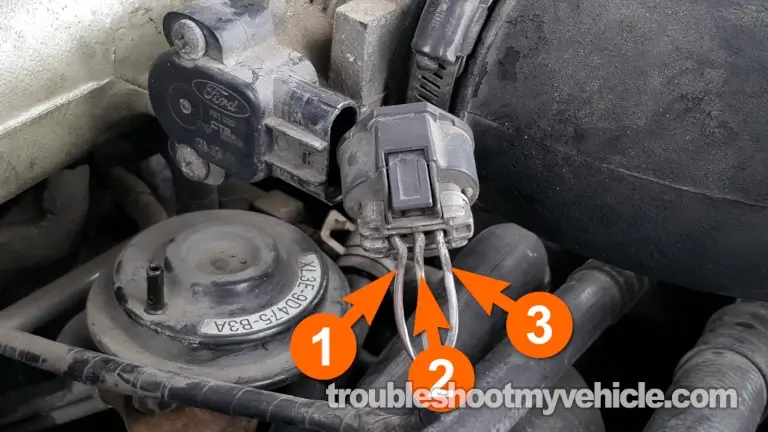
The throttle position sensor (TPS) is probably one of the easiest components to test on the 4.2L V6 Ford E150 or E250 van.
In this tutorial, I'll show you how to test it with a multimeter. With your test results, you'll be able to quickly find out if it's working correctly or if it's bad and needs to be replaced.
Contents of this tutorial:
- Symptoms Of A Bad Throttle Position Sensor.
- Throttle Position Sensor (TPS) Circuit Descriptions.
- Where To Buy The TPS And Save.
- TEST 1: TPS Voltage Signal Check Key On Engine Off.
- TEST 2: Testing The TPS Voltage Signal.
- TEST 3: Making Sure The TPS Is Receiving 5 Volts.
- TEST 4: Making Sure That The TPS Is Receiving Ground.
- More 4.2L Ford E150 And E250 Test Tutorials.
APPLIES TO: This tutorial applies to the following vehicles:
- 4.2L V6 Ford E150: 1997, 1998, 1999, 2000.
- 4.2L V6 Ford E250: 1997, 1998, 1999, 2000.
Symptoms Of A Bad Throttle Position Sensor
The throttle position sensor (TPS) is the component that tells the fuel injection computer how the throttle plate opens/closes as you're stepping on or off the accelerator pedal.
This throttle plate angle information is then sent to the fuel injection computer so that it can do it's little song and dance and keep the engine running optimally.
As you're probably already aware, when the throttle plate opens, more air enters the engine. As you let off the gas pedal the throttle plate closes and less air enters the engine. This makes the throttle position sensor a critical engine management component. So when it fails, you're going to see one or more of the following problems:
- Check Engine Light: The check engine light will be triggered by one of the following diagnostic trouble codes (DTCs):
- P0122: Throttle Position Sensor Circuit Low Input.
- P0123: Throttle Position Sensor Circuit High Input.
- Engine Performance Issues: You'll see one or more of the following:
- Engine hesitates when you step on the accelerator pedal.
- Lack of power when accelerating the vehicle.
- Engine idle either too high or too low.
- Rough engine idle.
- The engine may start and immediately stall.
- Bad Gas Mileage: The fuel injection computer will run an excessively rich air/fuel mixture which will hurt gas mileage.
- Engine No-Start: The engine cranks but does not start.
Throttle Position Sensor (TPS) Circuit Descriptions

I'm sure you've already noticed that the throttle position sensor has three wires coming out of its pigtail connector.
Each wire has a specific role, and the table below gives a brief description of each:
| Terminal | Wire | Description |
|---|---|---|
| 1 | Green with yellow stripe (GRN/YEL) | Ground (from PCM) |
| 2 | Red with black stripe (GRY/WHT) | TPS Signal |
| 3 | brown with white stripe (BRN/WHT) | 5 Volts (from PCM) |
Where To Buy The TPS And Save
The following links will help you comparison shop for the throttle position sensor (of known professional automotive brands- NO knock-offs):
TEST 1: TPS Voltage Signal Check Key On Engine Off

To get our TPS sensor diagnostic started, we're going to check the performance of the TPS.
This first test, we're going to do by connecting our multimeter to the TPS signal wire. With the key on engine off, we should have around 0.4 to 0.7 Volts DC.
The wire that we're going to connect our multimeter to, is the grey with white stripe (GRY/WHT) wire that I've labeled with the number 2.
Will do a simple multimeter test to confirm the 0.4 to 0.7 Volts DC in the TPS signal wire.
IMPORTANT: The throttle position sensor must remain connected to its connector in order to access the signal in the wire. You'll need to use a back-probe on the connector or a wire-piercing probe on the wire. You can see what this tool looks like and where to buy it here: Wire Piercing Probe.
Let's get started:
- 1
Place your multimeter in Volts DC mode.
- 2
Connect the red multimeter test lead to the grey with white stripe (GRY/WHT) wire of the TP sensor harness connector.
I've labeled the GRY/WHT wire with the number 2 in the photo above.
NOTE: The TPS must remain connected to its connector to test the TPS voltage signal. - 3
Connect the black multimeter test lead directly on the battery negative (-) post.
- 4
Turn the key on but don't crank or start the engine.
- 5
Your multimeter should register 0.4 to 0.7 Volts DC.
Let's analyze your test results:
CASE 1: The multimeter registered between 0.4 to 0.7 Volts DC. This is the correct test result.
Your next step is to go to: TEST 2: Testing The TPS Voltage Signal.
CASE 1: The multimeter DID NOT registered between 0.4 to 0.7 Volts DC. This tells you that something is definitely wrong with the TPS sensor.
Your next step is to go to: TEST 2: Testing The TPS Voltage Signal.

